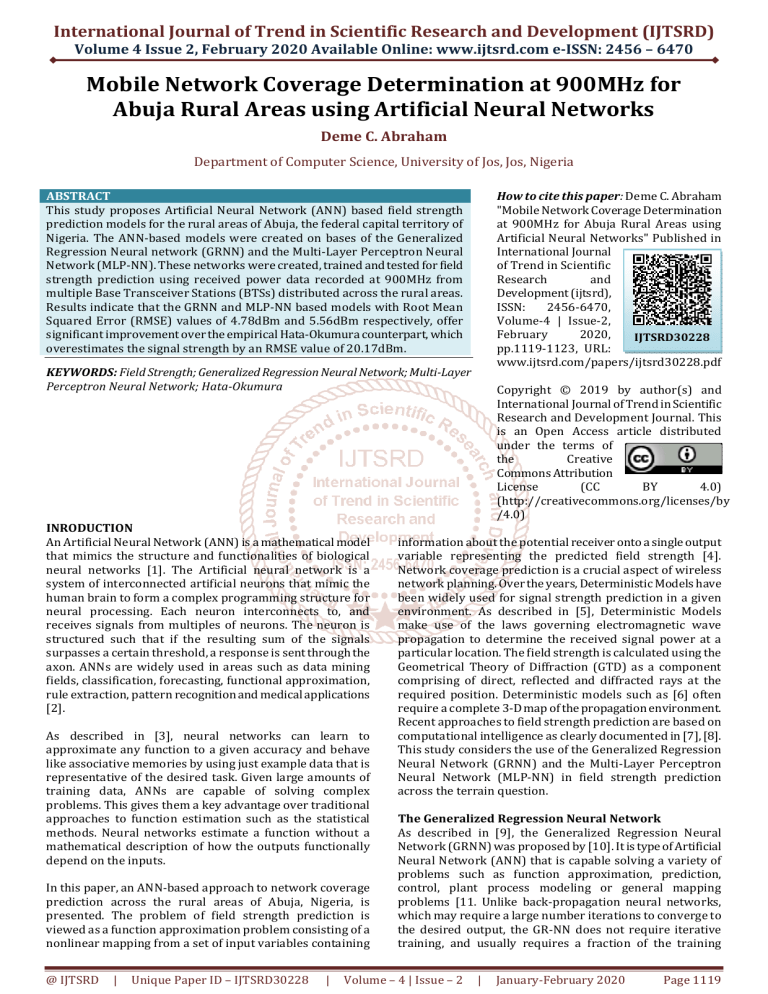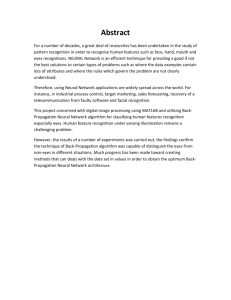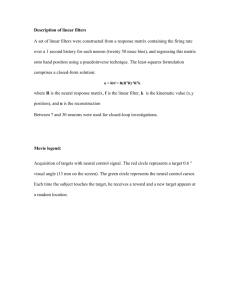
International Journal of Trend in Scientific Research and Development (IJTSRD)
Volume 4 Issue 2, February 2020 Available Online: www.ijtsrd.com e-ISSN: 2456 – 6470
Mobile Network Coverage Determination at 900MHz for
Abuja Rural Areas using Artificial Neural Networks
Deme C. Abraham
Department of Computer Science, University of Jos, Jos, Nigeria
How to cite this paper: Deme C. Abraham
"Mobile Network Coverage Determination
at 900MHz for Abuja Rural Areas using
Artificial Neural Networks" Published in
International Journal
of Trend in Scientific
Research
and
Development (ijtsrd),
ISSN:
2456-6470,
Volume-4 | Issue-2,
February
2020,
IJTSRD30228
pp.1119-1123, URL:
www.ijtsrd.com/papers/ijtsrd30228.pdf
ABSTRACT
This study proposes Artificial Neural Network (ANN) based field strength
prediction models for the rural areas of Abuja, the federal capital territory of
Nigeria. The ANN-based models were created on bases of the Generalized
Regression Neural network (GRNN) and the Multi-Layer Perceptron Neural
Network (MLP-NN). These networks were created, trained and tested for field
strength prediction using received power data recorded at 900MHz from
multiple Base Transceiver Stations (BTSs) distributed across the rural areas.
Results indicate that the GRNN and MLP-NN based models with Root Mean
Squared Error (RMSE) values of 4.78dBm and 5.56dBm respectively, offer
significant improvement over the empirical Hata-Okumura counterpart, which
overestimates the signal strength by an RMSE value of 20.17dBm.
KEYWORDS: Field Strength; Generalized Regression Neural Network; Multi-Layer
Perceptron Neural Network; Hata-Okumura
INRODUCTION
An Artificial Neural Network (ANN) is a mathematical model
that mimics the structure and functionalities of biological
neural networks [1]. The Artificial neural network is a
system of interconnected artificial neurons that mimic the
human brain to form a complex programming structure for
neural processing. Each neuron interconnects to, and
receives signals from multiples of neurons. The neuron is
structured such that if the resulting sum of the signals
surpasses a certain threshold, a response is sent through the
axon. ANNs are widely used in areas such as data mining
fields, classification, forecasting, functional approximation,
rule extraction, pattern recognition and medical applications
[2].
As described in [3], neural networks can learn to
approximate any function to a given accuracy and behave
like associative memories by using just example data that is
representative of the desired task. Given large amounts of
training data, ANNs are capable of solving complex
problems. This gives them a key advantage over traditional
approaches to function estimation such as the statistical
methods. Neural networks estimate a function without a
mathematical description of how the outputs functionally
depend on the inputs.
In this paper, an ANN-based approach to network coverage
prediction across the rural areas of Abuja, Nigeria, is
presented. The problem of field strength prediction is
viewed as a function approximation problem consisting of a
nonlinear mapping from a set of input variables containing
@ IJTSRD
|
Unique Paper ID – IJTSRD30228
|
Copyright © 2019 by author(s) and
International Journal of Trend in Scientific
Research and Development Journal. This
is an Open Access article distributed
under the terms of
the
Creative
Commons Attribution
License
(CC
BY
4.0)
(http://creativecommons.org/licenses/by
/4.0)
information about the potential receiver onto a single output
variable representing the predicted field strength [4].
Network coverage prediction is a crucial aspect of wireless
network planning. Over the years, Deterministic Models have
been widely used for signal strength prediction in a given
environment. As described in [5], Deterministic Models
make use of the laws governing electromagnetic wave
propagation to determine the received signal power at a
particular location. The field strength is calculated using the
Geometrical Theory of Diffraction (GTD) as a component
comprising of direct, reflected and diffracted rays at the
required position. Deterministic models such as [6] often
require a complete 3-D map of the propagation environment.
Recent approaches to field strength prediction are based on
computational intelligence as clearly documented in [7], [8].
This study considers the use of the Generalized Regression
Neural Network (GRNN) and the Multi-Layer Perceptron
Neural Network (MLP-NN) in field strength prediction
across the terrain question.
The Generalized Regression Neural Network
As described in [9], the Generalized Regression Neural
Network (GRNN) was proposed by [10]. It is type of Artificial
Neural Network (ANN) that is capable solving a variety of
problems such as function approximation, prediction,
control, plant process modeling or general mapping
problems [11. Unlike back-propagation neural networks,
which may require a large number iterations to converge to
the desired output, the GR-NN does not require iterative
training, and usually requires a fraction of the training
Volume – 4 | Issue – 2
|
January-February 2020
Page 1119
International Journal of Trend in Scientific Research and Development (IJTSRD) @ www.ijtsrd.com eISSN: 2456-6470
Samples a back-propagation neural network would need
[10]. As shown in Fig. 1, the GRNN comprises of four layers:
Summation layer: This layer comprises of two parts: the
Numerator and the Denominator. The Numerator sums up
products of training data and activation function, while the
Denominator sums up activation functions.
Output layer: The single neuron contained in this layer
generates the output through division of the Numerator by
the Denominator obtained from the previous layer.
The general regression as described by [10] is as follows:
given a vector random variable, x, and a scalar random
variable, y, and assuming X is a particular measured value of
the random variable y, the regression of y on X is given by
(1)
(1)
Fig. 1: Generalized Regression Neural Network
Architecture [12]
If the probability density function
Input layer: This is the first layer and it is responsible for
sending inputs to the next layer called the pattern layer
Pattern layer: This layer computes the Euclidean distance
between input and training data, and also the activation
function.
is unknown, it is
estimated from a sample of observations of x and y. The
probability estimator
, given by (9) is based upon
sample values
and
of the random variables x and y,
where n is the number of sample observations and
is the
dimension of the vector variable x.
(2)
A physical interpretation of the probability estimate
is that it assigns a sample probability of width
,
(called the
spread constant or smoothing factor) for each sample
and
, and the probability estimate is the sum of those sample
probabilities.
The scalar function
is given by (3)
The Multi-Layer Perceptron Neural Network
The Multi-Layer Perceptron Neural Network (MLP-NN) is a
feed forward neural network trained with the standard back
propagation algorithm [13]. As described in [14], the MLPNN is a supervised network so it requires a desired response
to be trained. With one or two hidden layers, the MLP-NN
can approximate virtually any input-output map. They have
been shown to approximate the performance of optimal
statistical classifiers in difficult problems.
wji
(3)
woj
x0
x1
y
...
...
...
Combining equations (1) and (2) and interchanging the
order of integration and summation yields the desired
conditional mean
, given by (4)
Input
Layer
Hidden
Layer
xn-1
(4)
It is further stated in [10] that when the smoothing
parameter is made large, the estimated density is forced to
be smooth and in the limit becomes a multivariate Gaussian
with covariance . On the other hand, a smaller value of
allows the estimated density to assume non-Gaussian
shapes, but with the hazard that wild points may have too
great an effect on the estimate.
@ IJTSRD
|
Unique Paper ID – IJTSRD30228
|
Output
Layer
Fig.2: Multilayer Perceptron Neural Network with one
hidden layer [14]
The MLP-NN comprises of an input layer, one or more
hidden layers and an output layer. Fig. 2 shows an
architecture with 1 hidden layer. It can be observed that
each neuron of the input layer is connected to each neuron of
the hidden layer, and in turn, each neuron of the hidden
layer is connected to the single neuron of the output layer.
Signal propagation across the entire network is always in the
forward direction, i.e, from the input layer, through the
Volume – 4 | Issue – 2
|
January-February 2020
Page 1120
International Journal of Trend in Scientific Research and Development (IJTSRD) @ www.ijtsrd.com eISSN: 2456-6470
hidden layer and eventually to the output layer. Error signals
propagate in the opposite direction from the output neuron
across the network. As described in [14] the output of the
MLP-NN is given by (5)
M
N
y = F0 ∑ w 0 j Fh ∑ w ji x i
j=0
i =0
where:
woj represents the synaptic weights from neuron j in the
hidden layer to the single output neuron,
xi represents the ith element of the input vector,
Fh and F0 are the activation function of the neurons from
the hidden layer and output layer, respectively,
wji are the connection weights between the neurons of
the hidden layer and the inputs.
The learning phase involves adaptively adjusting the free
parameters of the system based on the mean squared error
E, between predicted and measured path loss for a set of
appropriately selected training examples. The mean squared
error is given by (6),
E=
1 m
2
( yi − d i )
∑
2 i =1
Where, yi is the output value computed by the network and
di is the desired output. When the error between network
output and the desired output is minimized, the learning
process is terminated and the network can be used in a
testing phase with test vectors. At this stage, the neural
network is described by the optimal weight configuration,
which means that theoretically ensures the output error
minimization.
The Hata-Okumura Model
As described in [15] the Hata-Okumura Model incorporates
the graphical information from the Okumura Model. The
Hata Model is a widely used propagation model for
predicting path loss in urban areas, and also has
formulations for predicting path loss in Suburban and Open
Areas. The Hata Model for Urban Areas is valid for the
following parameters:
Frequency Range: 150 MHz to 1500 MHz
Transmitter Height: 30 m to 200 m
Link distance: 1 km to 20 km
Mobile Station (MS) height: 1 m to 10 m
Where,
LU - Path loss in Urban Areas
hB - Height of base station antenna in meters (m)
hM - Height of mobile station antenna in meters (m)
f - Frequency of Transmission in megahertz (MHz).
CH - Antenna height correction factor
d - Distance between the base and mobile stations in
kilometers (km).
The Hata Model for Suburban Areas is given by (8)
(8)
Hata model for open areas is formulated as (9)
(9)
Materials and Methods
A. Received Power Measurement and Path Loss
Computation
Received power measurements were recorded from multiple
Base Transceiver Stations (BTSs) situated within the Abuja
rural areas between Abaji and Gwagwalada, as well as
Gwagwalada and Zuba. The BTSs belong to the mobile
network service provider, Mobile Telecommunications
Network (MTN), Nigeria. The instrument used was a Cellular
Mobile Network Analyser (SAGEM OT 290) capable of
measuring signal strength in decibel milliwatts (dBm).
Received power (PR) readings were recorded within the
900MHz frequency band at intervals of 0.15km, after an
initial separation of 0.1km. Mobile Network Parameters
obtained from the Network Provider (MTN) include Mean
Transmitter Height of 33 meters and Mean Effective
Isotropic Radiated Power (EIRP) of 45dBm.
Statistical Indices for Performance Comparison
The performance comparison indices adopted in this study
are based on the Root Mean Square Error (RMSE), given by
(10), and the Coefficient of Determination (R2), given by
(11). The RMSE is a measure of the differences between
predicted and observed values. The smaller the RMSE value,
the higher the prediction accuracy of the model. R2 ranges
from 0 to 1, but can be negative, which indicates the model is
inappropriate for the data. A value closer to 1 indicates a
greater correlation of the model with the test data, and
hence, greater fit.
(10)
Hata Model for Urban Areas is formulated as (7).
Where,
M – Measured Path Loss
P – Predicted Path Loss
N- Number of paired values
(7)
For small or medium sized cities (where the mobile antenna
height is not more than 10 meters),
(11)
Where
yi is the measured path loss,
is the predicted path loss and
and for large cities,
is the mean of the measured path loss values.
@ IJTSRD
|
Unique Paper ID – IJTSRD30228
|
Volume – 4 | Issue – 2
|
January-February 2020
Page 1121
International Journal of Trend in Scientific Research and Development (IJTSRD) @ www.ijtsrd.com eISSN: 2456-6470
Results and Discussion
Figures 3 to 8 clearly indicate that the empirical HataOkumura model overestimates the signal strength across all
the BTSs considered in this investigation. On the contrary, it
can be observed that the ANN-based predictors are
convergent towards the test data, indicating greater
prediction performance. The statistical performance indices
in Table 1 indicate that on the average, the GRNN-based
predictor is the most accurate of the three predictors with a
RMSE value of 4.78dBm and R2 value of 0.82. The MLP-NN
model has a RMSE value of 5.56dBm and R2 value of 0.68.
The Hata-Okumura model with a RMSE value of 20.17dBm
clearly overestimates the signal strength as earlier stated.
TABLE1. Statistical Performance Comparison of Predictors
STATS.
BST 1 BST 2 BST 3 BST 4 BST 5 BST 6
RMSE(dBm) 5.08
5.49
4.86
5.34
3.58
4.31
GRNN
R2
0.82
0.75
0.84
0.86
0.80
0.87
5.22
5.00
4.35
8.17
4.51
RMSE(dBm) 6.12
MLP-NN
2
R
0.74
0.78
0.83
0.91
-0.02
0.85
RMSE(dBm) 22.15 19.82 21.63 19.84 17.18 20.40
Hata - Okumura
R2
-2.55
-1.95
-2.02
-0.92
-2.81
-2.06
MODEL
@ IJTSRD
MEAN
4.78
0.82
5.56
0.68
20.17
-2.05
Fig. 3: Model Comparison for BTS 1
Fig. 6: Model Comparison for BTS 4
Fig. 4: Model Comparison for BTS 2
Fig. 7: Model Comparison for BTS 5
Fig.5: Model Comparison for BTS 3
Fig. 8: Model Comparison for BTS 6
|
Unique Paper ID – IJTSRD30228
|
Volume – 4 | Issue – 2
|
January-February 2020
Page 1122
International Journal of Trend in Scientific Research and Development (IJTSRD) @ www.ijtsrd.com eISSN: 2456-6470
Conclusion
Field strength prediction models for the rural areas of Abuja,
Nigeria, were created on the bases of two types of ANN,
which were trained and tested with received power data
recorded at an operating frequency of 900MHz from
multiple Base Transceiver Stations situated across the rural
areas. The two deep learning networks considered were the
Generalized Regression Neural network (GRNN) and MultiLayer Perceptron Neural Network (MLP-NN). Results
indicate that the ANN-based models offer significant
improvement over the empirical Hata-Okumura model.
References
[1] Andrej K., Janez B. and Andrej K. Introduction to the
Artificial Neural Networks, Artificial Neural Networks Methodological Advances and Biomedical Applications,
Prof. Kenji Suzuki (Ed.), ISBN: 978-953-307-243-2, pp
1, 2011
[2] Janmenjoy N., Bighnaraj N. (2015). A Comprehensive
Survey on Support Vector Machine in Data Mining
Tasks: Applications & Challenges. International Journal
of Database Theory and Application Vol.8, No.1 (2015),
pp.169-186, 2015.
[3] Faria P., Zita V., Joao P., Khodr H. (2009). ANN Based
Day-Ahead Spinning Reserve Forecast for Electricity
Market Simulation. Center of the Electr. Eng., Polytech.
Inst.
of
Porto
(IPP),
Porto,
Portugal
DOI: 10.1109/ISAP.2009.5352930
Conference:
Intelligent System Applications to Power Systems,
2009. ISAP '09. p. 2.
[4] Popescu I., Naforni I., Gavriloaia G. Field Strength
Prediction in Indoor Environment with a Neural
Network Model: FACTA UNIVERSITATIS (NIS), Series:
Electronics and Energetics. Vol. 14, No. 3, 2001, pp
329-336.
[7] Popescu I., Naforni I., Gavriloaia G. Field Strength
Prediction in Indoor Environment with a Neural
Network Model: FACTA UNIVERSITATIS (NIS), Series:
Electronics and Energetics. Vol. 14, No. 3, 2001, pp
329-336.
[8] Deme A. C. Field Strength Determination in a Tropical
Metropolitan Environment Using Computational
Intelligence Techniques. American Journal of
Engineering Research (AJER) e-ISSN: 2320-0847 pISSN: 2320-0936 Volume-5, Issue-8, pp-276-284, 2016
[9] Deme C. A. A Generalized Regression Neural Network
Model for Path Loss Prediction at 900 MHz for Jos City,
Nigeria. American Journal of Engineering Research
(AJER). E-ISSN: 2320-0847 p-ISSN: 2320-0936 Volume5, Issue-6, pp-01-07, 2016.
[10] Specht D. F.A. A general regression neural network.
IEEE Transactions on Neural Networks. 2, 1991, 568576.
[11] Leszek R. Generalized Regression Neural Networks in
Time-Varying Environment. IEEE Transactions on
Neural Networks, Vol. 15, No. 3, 2004, pp. 576-596.
[12] Sun G., Hoff S. J., Zelle B. C., Nelson M. A. Development
and Comparison of Back propagation and Generalized
Regression Neural Network Models to Predict Diurnal
and Seasonal Gas and PM10 Concentrations and
Emissions from Swine Buildings. American Society of
Agricultural and Biological Engineers ISSN 0001-2351.
Vol. 51(2):2008, pp. 685-694
[13] Gaurang P., Amit G., Y P Kosta and Devyani P.
“Behaviour Analysis of Multilayer Perceptrons with
Multiple Hidden Neurons and Hidden Layers”,
International Journal of Computer Theory and
Engineering, Vol. 3, No. 2, 2011, pp. 332-337.
[5] Sumit J. and Vishal G. A Review on Empirical Data
Collection and Analysis of Bertoni‟s Model at 1.8 GHz.
International Journal of Computer Applications (0975 –
8887) Volume 56, No.6, 2012, pp 17- 23.
[14] Popescu I., Naforni I., Gavriloaia G. Field Strength
Prediction in Indoor Environment with a Neural
Network Model: FACTA UNIVERSITATIS (NIS), Series:
Electronics and Energetics, 2001. Vol. 14, No. 3, pp
329-336.
[6] Athanasiadou G.E., Nix A.R., McGeehan J.P. „A
Microcellular Ray-Tracing Propagation Model and
Evaluation of its Narrowband and Wideband
Predictions‟, IEEE Journal on Selected Areas in
Communications, Wireless Communications series, vol.
18, no 3, 2000, pp. 322-335.
[15] Yuvraj S. (2012). Comparison of Okumura, Hata and
COST-231 Models on the Basis of Path Loss and Signal
Strength. International Journal of Computer
Applications (0975 – 8887) Volume 59, No.11, 2012,
pp. 37-41.
@ IJTSRD
|
Unique Paper ID – IJTSRD30228
|
Volume – 4 | Issue – 2
|
January-February 2020
Page 1123




